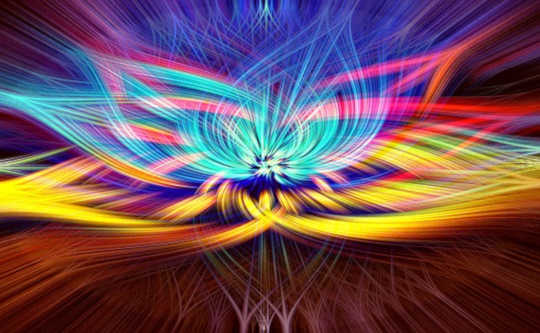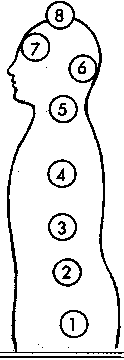
Understand that thou art another world in little,
and hast within thee the Sun and the Moon,
and also the stars.
-- Origen (185/86-254/55 C.E.)
In this article I would like to explore the exciting possibility of bridging two of history's greatest psychological systems -- astrology and the chakras. Conventionally, these two systems have been seen as having little or nothing to do with each other, the former primarily concerning the outer world, or macrocosm, and the latter involving the inner world, or microcosm. In fact, as we shall soon see, these two systems are but two sides of the same coin, each one complementing the other and thus enhancing our understanding of both.
Toward a Sacred Psychology of the Horoscope
The basic system of correspondences I will be using here is drawn from teachers I have studied with in the Kriya Yoga lineage. The general system of "chakric horoscopes" and their guidelines for interpretation are my own, developed over more than a decade of working with these basic correspondences. With that said, let us begin by exploring some of the core ideas of chakric philosophy.
In Sanskrit, the word chakra (sometimes spelled "cakra") literally means "wheel". In yogic philosophy, this term refers to the psychospiritual centers located along the length of the spine, each of which is associated with a different archetypal principle of consciousness. Although there are literally thousands of chakras situated throughout the subtle body, yogic philosophy normally stresses only seven or eight of these. Let us briefly review these primary points and their planetary associations.
What Are the Chakras?
Chakra 1, at the base of the spine, is called Muladhara. Its element is earth, and it is governed by the planet Saturn. Psychologically, it concerns one's relationship with the material plane, and the principle of limitation in both its constructive and destructive aspects. In its more unbalanced expression, it governs the drive for survival, as well as such states as greed and fear, while its more balanced expression points to such qualities as practicality and worldly skillfulness (business, science, etc.).
Chakra 2 is called Svadisthana. Its element is water, and it is ruled by the planet Jupiter. Psychologically, it is one of the centers concerned with emotions. At its grosser levels of expression, it governs such states as escapism, excess, and dogmatism, while its more constructive expressions include enthusiasm and religious devotion.
Chakra 3 is called Manipura. Its element is fire, and Mars is its governing planet. This chakra rules over emotions in their more dynamic and energetic forms. Thus, in its less refined state, it relates to anger and combativeness, and is more positively expressed as strength and assertiveness.
Chakra 4 is called Anahata. Its element is air, and its corresponding planet is Venus. The psychological focus is on love, beauty, and allurement, and it governs the capacity for harmony in all romantic and social interactions. In its unbalanced form, it produces a tendency toward hedonism, pleasure-seeking, and excessive "sweetness" of temperament, while, when in balance, it can give rise to an exceptional sense of aesthetics, and even unselfish love.
Chakra 5 is called Vishudda. Its element is ether, and it is governed by the planet Mercury. This chakra's psychological focus is upon mental self-expression and one's ability to formulate or verbalize thoughts. When unbalanced, it produces chaotic thoughts and/or communications, while its constructive expression tends toward creative spiritual thinking and refined communication skills.
Chakra 6 is called Chandra, and is ruled by the Moon. Though overlooked in most published discussions of the chakras, Paramahansa Yogananda described this as the feminine polarity of the Ajna chakra, or "third eye" (to be considered next). Its emphasis is upon awareness in its most reflective or introspective mode, and it governs such qualities as nurturing compassion and psychic sensitivity. Its more destructive expressions include the experience of fearfulness, emotional dependency, and a preoccupation with the past.
Chakra 7 is called Ajna and is located in the center of the forehead, also known as the "third eye". Its corresponding planet is the Sun, and it governs the principle of pure consciousness in its most active, visionary, and expressive form, as well as the higher will. In its balanced state, it rules creativity, spiritual energy, and self-expression, while in unbalanced form it can manifest as egoism, willfulness, "dry" awareness without compassion, and the drive for attention.
Chakra 8 is called Sahasrara, the "crown chakra" or "thousand-petaled lotus", and exists at the top of the head above the other chakras. Whereas the previous Ajna chakra represents the supreme realization of personal divinity (perceived in meditation as a fivepointed star), the Sahasrara rules our point of contact with the transpersonal divine, the level of "Godconsciousness". However, because this chakra represents a transcendental point beyond the more personal chakras (and, by inference, their astrological correlates), it is largely dormant for most individuals, and can, for purposes of clarity, be left out of our subsequent discussion.
Chakra Planet Keywords
 (8) Sahasrara: The Transcendent, Inspiration
(8) Sahasrara: The Transcendent, Inspiration
(7) Ajna - Sun: Active Awareness, Higher Will
(6) Chandra - Moon: Reflective Awareness, Memory
(5) Vishudda - Mercury: Thinking, Communication
(4) Anahata - Venus: Harmony, Love
(3) Manipura - Mars: Force, Strength, Control
(2) Svadisthana - Jupiter: Expansiveness, Emotionality
(1) Muladhara - Saturn: Structure, Limitation
The Twelve Secondary Chakric States
Thus far we have been looking at the chakras only in their simplest possible description. In fact, most of the chakras possess at least three different aspects, or faces: feminine (introverted), masculine (extroverted), and spiritual (balanced). In other words, each chakra can be diverted over to either its right side or its left side, or it can be experienced in a perfectly balanced fashion in the very center of the spine. In their right- and left-hand aspects, the chakras are associated with the twelve signs of the zodiac.
In each of these three aspects, the psychological energy of any given chakra will manifest in uniquely different ways. For example, when experienced in its more masculine mode (Gemini), the fifth, or Mercury, chakra will generally manifest as interpersonal communications in the waking world, while its more feminine side (Virgo) will tend toward more internalized thought processes, or perhaps even appear within the dream state. In its balanced state within the central channel, however, Mercury rules the mystical mind, that aspect of mentality which truly communes with spirit.
Some traditional esoteric sources, such as Cornelius Agrippa, expressed much the same idea in the following way: Saturn rules Aquarius by day and Capricorn by night; Jupiter rules Sagittarius by day and Pisces by night; Mars rules Aries by day and Scorpio by night; Venus rules Libra by day and Taurus by night; Mercury rules Gemini by day and Virgo by night; while the Sun and Moon hold rulership over one sign each, Leo and Cancer. Yet it is only in the very center of each chakric level that the energy of that chakra truly manifests in a spiritually-balanced fashion, beyond the dualistic qualities of the zodiacal wheel.
In its broadest sense, the seven classical planets relate to the twelve signs in a startlingly precise way. One simply spins the zodiac around until they fall into line with these chakric placements.
What to do with the three outer planets? They fall into line with the first three chakras, in accordance with the zodiacal signs they are commonly associated with by rulership. Hence, Pluto equates to the feminine side of the Mars chakra (Scorpio), Neptune to the feminine side of the Jupiter chakra (Pisces), and Uranus to the masculine side of the Saturn chakra (Aquarius).
In yogic philosophy, each of these peripheral chakric centers represents a kind of memory tract or "storage bin" for karmas and life impressions; whatever we feel, think, and experience is logged into the energy fields of the spinal column. In this way, habit patterns (or samskaras, in yogic terminology) are built up over time, and etched into the subconscious psyche, where they continue to compel us toward particular behaviors from lifetime to lifetime.2
The Chakric Science of Personality
Every personality is comprised of these basic archetypal elements, although in widely varying combinations. Depending on an individual's karmic patterns, subtle energies concentrate themselves in different areas of the chakric system, where they are then employed toward either constructive or destructive ends. In this manner, complex patterns are constellated throughout an individual's chakric centers. Although every person experiences all of these centers to one degree or another, certain chakras will tend to be more dominant for some than for others. Hence, a more artistic person may have the fourth chakra emphasized, whereas an intellectual type may have the fifth chakra emphasized, and so forth.
One useful way to illustrate this point is through the notion of sub personalities, since each chakra has its own unique traits or "personifications". Utilizing this system of correspondences, we can describe the different chakras in the following way: the first, or Saturn, chakra can be metaphorically described as the "Inner Politician" or the "Inner Architect"; the second, or Jupiter, chakra is the "Inner Optimist" or the "Inner Preacher"; the third, or Mars, chakra is, plain and simple, the "Inner Warrior"; the fourth, or Venus, chakra is the "Inner Lover," or the "Inner Artist"; the fifth, or Mercury, chakra is the "Inner Communicator" or the "Inner Thinker"; the sixth, or lunar, chakra is the "Inner Mother" or the "Inner Queen"; the seventh, or solar, chakra is the "Inner Father" or the "Inner King". Certain chakric levels will be emphasized in any given horoscope, and this will determine an individual's most dominant sub-personalities.
Chakric interpretation using the signs
We have seen how the twelve signs closely correspond to the different chakras by spinning the zodiac around until Cancer and Leo are positioned at the top of the wheel. The placement of a person's planets within these different signs will therefore provide important clues as to which chakric levels are emphasized. For example, any large constellation of planets in Libra or Taurus would indicate a heavy focus of attention, karmically speaking, on the lessons of the heart, or fourth, chakra, while planets in Scorpio or Aries would indicate a focus of energies on the naval, or third, chakra, and so forth. In theory, these chakric emphases would manifest as energy patterns within those corresponding areas of the person's aura, which would in turn be perceptible to sufficiently clairvoyant individuals.
This kind of interpretation can be refined to a considerable degree since each planet is subtly different in the way it amplifies any given chakric level. For example, Saturn located in one chakra has a dramatically different effect than when Jupiter is found in that same chakric center. Specifically, wherever Saturn is placed shows in what area of experience one may feel especially challenged to grow, or, in its most frustrating form, where one may feel denied in some way. In a subtler sense, of course, the placement of Saturn indicates the chakric level at which one may also find the greatest depth of wisdom carried over from past lives. In any event, one would probably have to work very hard for desired results in the chakric level inhabited by Saturn, although for that very reason one might also have a much greater appreciation for the rewards of that chakra, just as a man stranded in the desert would have greater appreciation for a glass of water than a man swimming in a river. By contrast, in whatever chakra Jupiter is placed indicates where one experiences more obvious blessings and good fortune, where there is a more fluid opening and expression of life energies -- possibly to excess.
Arguably, the most important significators to look for, chakrically, are the Sun, Moon, and Ascendant. Simply by studying these basic points, one can, I believe, learn a great deal about an individual's chakric focus in this life. For instance, Sun in Gemini would strongly suggest a heightened focus upon the throat chakra of mentality and communication, whereas Sun in Capricorn would point to an intense direction of energies toward the earth plane and the establishment of success, recognition, or simply balance on this level. As most astrologers know, these primary indicators (Sun, Moon, and Ascendant) have their own unique and subtly different shades of meaning -- a source of lively debate among astrologers over the years. My own feeling on this matter is that the Moon indicates the chakric level one is coming from both emotionally and karmically; the Ascendant shows where the everyday personality in this life is presently at, in terms of visible, habitual ways of thinking and relating; and the Sun indicates the chakric direction one is aspiring toward in this life, and which one is attempting to bring into creative manifestation.
This, then, has been only the briefest introduction to yogic chakric philosophy, and some of the ways it can illuminate our understanding of the conventional, or Western horoscope. It is my hope that in the years to come the further exploration of this synthesis will provide us with the foundation for a true "sacred psychology," one that more fully unlocks astrology's spiritual potentials.
Article Source
 This article has been adapted from Ray Grasse's book The Waking Dream: Unlocking the Symbolic Language of Our Lives (publisher: Quest Books). An expanded discussion of the practical aspects of interpreting chakric horoscopes are featured in Eastern Systems for Western Astrologers: An Anthology, published by Weiser Publications.
This article has been adapted from Ray Grasse's book The Waking Dream: Unlocking the Symbolic Language of Our Lives (publisher: Quest Books). An expanded discussion of the practical aspects of interpreting chakric horoscopes are featured in Eastern Systems for Western Astrologers: An Anthology, published by Weiser Publications.
Info/Order the book: The Waking Dream
Info/Order the book: Eastern Systems for Western Astrologers
Order Signs of the Times.
©1995 Ray Grasse - all rights reserved.
This article was excerpted from a longer article
published in The Mountain Astrologer, April 1996.
www.MountainAstrologer.com
About The Author
 Ray Grasse is associate editor of The Mountain Astrologer Magazine, and author of the book The Waking Dream: Unlocking the Symbolic Language of Our Lives (Quest, 1996), and the forthcoming Signs of the Times (Hampton Roads, April 2002), an examination of the Aquarian Age. Ray maintains an active astrological practice, and can be reached via his website https://www.raygrasse.com/
Ray Grasse is associate editor of The Mountain Astrologer Magazine, and author of the book The Waking Dream: Unlocking the Symbolic Language of Our Lives (Quest, 1996), and the forthcoming Signs of the Times (Hampton Roads, April 2002), an examination of the Aquarian Age. Ray maintains an active astrological practice, and can be reached via his website https://www.raygrasse.com/
More books by this Author
at InnerSelf Market and Amazon

























